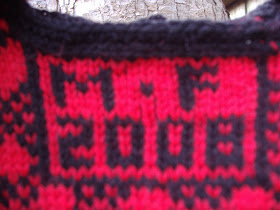
IN SIX SIZES
MATERIALS:
PATONS MOORLAND KNITTING. 13ozs. Rust No.2460 (40-13 ozs.) (42 and 44-14 ozs.) (46 and 48-15 ozs.).
Two No. 10 and two No. 8 Queen Bee Knitting Needles for sizes 38,42 and 46.
Two No.12 and two No.7 Knitting Needles for sizes 40,44 and 48.
One spare needle with points at both ends.
Tension: 5.5 sts and 7 rows =1" with No. 8 needles.
5 sts and 6 rows =1" with No.7 needles.
TO MAKE THE "TWIST": Slip next 5 sts onto the spare needle, letting this needle fall to back of work. Knit next 5 sts. Bring spare needle to front of work and knit next 5 sts. Knit the 5 sts. from spare needle.
FRONT: With No.10 needles (all sizes)cast on 112 sts (40-112)(42 and 44-124 sts) (46 and 48-136 sts).
1st row: K2 *P1 K1. Repeat from * to end of row. Repaeat 1st row for 3.5".
Next Row: K5 (P2K4) twice. P2 K2 (Inc 1 st in next st K1) 4 times. K1 P2 K4 P2 K2. (Inc 1 st in next st, K1)4 times. K1 (P2K2) twice. P2 K2 (Inc 1 st in next st K1) 4 times. K1 P2 K4 P2 K2 (Inc 1 st in next st. K1) 4 times.* K1 (P2 K4)3 times. K1. 128 sts on needle (40 as 38) (42 and 44-K5 (P2 K4) 3 times. P2 K2 Repeat from * to * as given for siz3 38. K1 (P2 K4) 4 times. K1. 140 sts on needle). (46 and 48-K5 (P2 K4) 4 times. P2 K2 Repeat from * to* as given for size 38. K1 (P2 K4)5 times. K1 152 sts on needle).
Change to No.8 needles for sizes 38, 42 and 46.
Change to No.7 needles for sizes 40,44 and 48.
Proceed-
1st row: K1 (all sizes) (P4K2)3 times. (40-3 times) (42 and 44 -4 times) (46 and 48-5 times). P15 K2 P4 K2 P15 (K2 P4)twice. K2 P15 K2 P4 K2 P15*K2 P4. Repeat from * to last st. K1
**2nd Row: K5 (all sizes) (P2 K4)twice. (40-twice) (42 and 44-3 times) (46 and 48-4 times). P2 Twist P2 K4 P2 Twist (P2 K4) twice. P2 Twist P2 K4 P2 Twist *P2 K4 Repeat from * to last st. K1.
3rd row: As 1st row.
4th row: K5 (all sizes). (P2 K4) twice. (40-twice) (42 and 44-3times) (46 and 48-4 times). P2 K15 P2 K4 P2 K15 (p2 K4)twice. P2 K15 P2 K4 P2 K15. *P2 K4. Repeat from * to last st. K1.
5th Row: As 1st row. Repeat 4th and 5th rows 4 times. ** Repeat from ** to** until work measures 14" from beginning or desired lentgh. (all sizes).
To shape armholes: Keeping continuity of pattern, cast off 8 sts. (40-8sts) (42 and 44-9sts) (46 and 48-10 sts). beginning next 2 rows, then dec. 1 st each end of needle on next and every alternate row to 92 sts on needle. (40-92sts) (42 and 44-98sts) (46 and 48-104sts).
Continue even in pattern until armhole from first shaping measures 6.5" (40 and 42-7") (44 and 46 and 48-7.5").
To shape neck: Work 37 sts (40-37sts) (42 and44-40sts) (46 and 48-43 sts) in pattern. Turn.
Leaving remaining sts on spare needle continue in pattern on these 37sts (40-37 sts) (42 and 44-40 sts) (46 and 48-43 sts) dec. 1 st at neck edge every row to 24 sts on needle. (40-24sts)(42 and 46-26 sts) (46 and 48-28sts).
Continue even in pattern until armhole from first shaping measures 9". (40 and 42-9.5") (44 and 46-10") (48-10.5")
To shape shoulder: Keeping continuity of pattern, at armhole edge cast off 12 sts. (40-12sts) (42 and 44-13 sts) (46 and 48-14sts) every alternate row twice.
Leaving next 18 sts. (all sizes) on spare needle, join wool to remaining 37 sts. (40-37sts)(42 and 44-40sts) (46 and 48-43 sts) and work other side to correspond.
BACK: With No.10 needles (all sizes) cast on 112 sts. (40-112sts) (42 and 44-124sts) (46 and 48-136sts).
Work exactly as given for Front to 92 sts on needle (40-92sts) (42 and 44-98sts) (46 and 48-104sts).
Continue even in pattern until armhole from first shaping measures 9". (40 and 42-9.5") (44 and 46-10") (48-10.5")
With right side of work facing, proceed:-
To shape shoulders: Keeping continuity of pattern cast off 12 sts. (40-12sts) (42 and 44-13 sts) (46 and 48-14sts) beginning next 4 rows.
Do not break wool.
NECKBAND: Sew left shoulder seam. With right side of work facing and No.10 needles, knit across sts at back of neck. Pick up and knit 14 sts (40-14sts)(43 and 44-16sts) (46 and 48-18sts) along right side of neck.
Work 1" ribbing (K1 P1). Cast off loosely in ribbing.
ARMBANDS: Sew right shoulder seam. With right side of work facing and No.10 needles, pick up and knit 140 sts. (40 and 42-144sts)(44 and 46-148sts)(48-152sts). along armhole.
Work 1" ribbing (K1P1). Cast off loosely in ribbing.
TO MAKE UP: Press carefully. Sew side seams.

Originally published by Paton's
::dreamy::



















 To close, sc3tog as possible, then tie off leaving a long tail. Thread this tail on a needle and sew close. Snip, but keep your tails!
To close, sc3tog as possible, then tie off leaving a long tail. Thread this tail on a needle and sew close. Snip, but keep your tails!
































